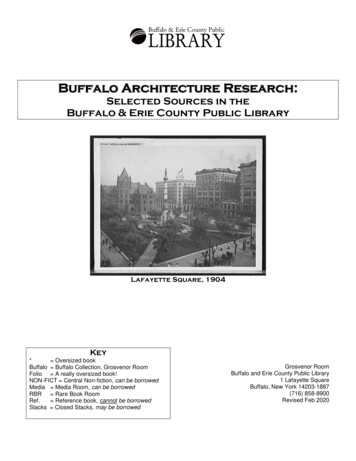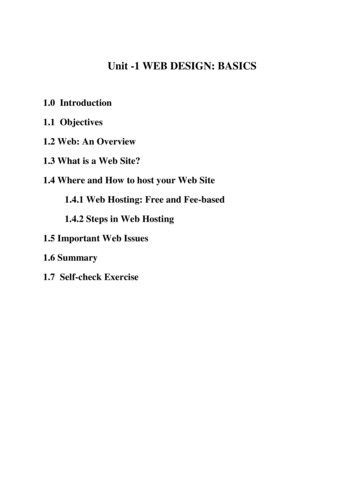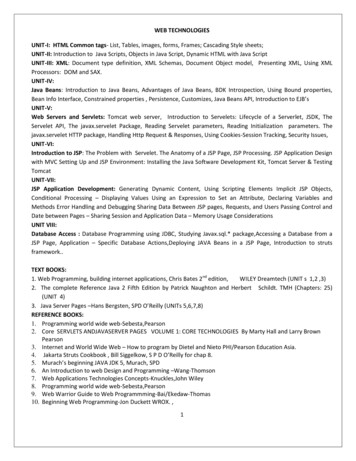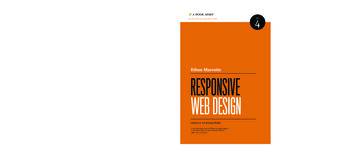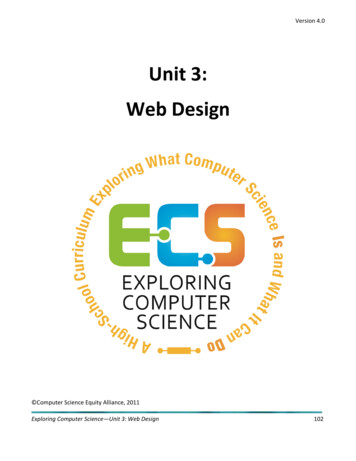
Transcription
Version 4.0Unit 3:Web Design Computer Science Equity Alliance, 2011Exploring Computer Science—Unit 3: Web Design102
Version 4.0IntroductionThe Web Design unit builds on the concepts presented in the previous units by having students apply problemsolving strategies to web design; thus, it also serves as a bridge to the Introduction to Programming unit asstudents move from user to creator. The unit also provides an opportunity to expand upon the issues of ethicsand privacy related to the internet that were introduced in the first unit.The basics of html and css are introduced as a method for describing features of web pages that students canuse to design and develop web pages based on their own culture, interests and unique experiences.The html and css lessons are scaffolded in order to provide all students an entry point, but it is likely that asstudents explore they will encounter features they wish to add for which they do not yet know the correct tags.Many students will be able to figure these out on their own and should be encouraged to do so.Resist the temptation to provide lists of appropriate font and color palettes and/or best layout designs. Asstudents experiment and share their work, challenge them to explain why they chose the features they did andencourage peers to comment.Example projects are provided as a starting point, but students should be encouraged to work on projects thatare authentic for them. They may choose to create web pages on different topics for each assigned project orbuild on a prior one as appropriate.There are two supplements—Flash animation and Javascript—at the end of the unit for use if there is additionaltime and interest.Specific topics for each instructional day are listed in the overview chart on the next page.Exploring Computer Science—Unit 3: Web Design103
Version 4.0Daily Overview ChartInstructional DayTopic1-2Explore issues of social responsibility in web use as well as the relativemerits of the influence of the web on society, personal lives, andeducation.3-4Introduce the use of basic html.5Introduce basic formatting in html.6-7Explore image editing for the web using Photoshop or an image editor ofchoice.Introduce basic css.8-1011-13Explore the concept of separating style from structure by keeping separatehtml and css files.14Add hyperlinks to other websites.15-16Introduce a variety of page layout styles.17-19Practice the use of various design elements.20-21Introduce several different enhancements for website design, includingweb user interface elements combining Javascript, html, css, andPhotoshop, accordion menus, lightbox and sliding images.Final projects and gallery walk22-25Exploring Computer Science—Unit 3: Web Design104
Version 4.0Daily Lesson PlansInstructional Days: 1-2Topic Description: This lesson engages students in a discussion of the web as social experience. Issues of socialresponsibility in web use are explored as well as the relative merits of the influence of the web on society,personal lives, and education.Objectives:The student will be able to: Set up a blog.Explain basic security issues on the internet.Identify web applications which influence society and education.Identify appropriate vs. inappropriate use of social websites.Outline of the Lesson: Set up a blog (25 minutes)Discussion of online security issues (20 minutes)Blog entry of students’ online experiences (10 minutes)Discussion of parts 1-3 of Growing Up Online from the PBS series Frontline (40 minutes)Blog entry reflecting on Growing Up Online (15 minutes)Student Activities: Set up a blog.Participate in discussion of online security.Create a blog entry on online experiences.Participate in a discussion about online experiences with social networking sites, blogs, email, onlinechatting and the kind of impact it has had on their lives.View and discuss Growing Up Online.Create a Blog entry reflecting on Growing Up Online.Teaching/Learning Strategies: Set up a blogo Complete the portions of the setup that were not done prior to class.o Guide a discussion of online security as students work on setting up their blogs.Create a blog entry on online experiences.o Show students how to create a blog entry using the blogging tool chosen for the class.o Have students create an entry that describes some of their current online experiences.Exploring Computer Science—Unit 3: Web Design105
Version 4.0 Guide a discussion regarding student use of social networking applications. (Note: This discussion maybe a review of discussions from Unit 1.) Ask questions such as:o Which social networking applications do you use? (blogging, Facebook, MySpace)o How often? How many of your friends use them?o How important are these web applications to your lives? How have they changed your lives? Living their lives essentially online A revolution in classrooms and in social life Self expression, trying on new IdentitiesDisplay parts 1-3 of Growing Up Online from the PBS series Frontline.o After viewing the video, lead a discussion on the content.Blog entry reflecting on Growing Up Onlineo Have students create a blog entry reflecting on the video. Did any of their thoughts change afterviewing the video?Note: Helping each student set up a blog will require some time outside of class and should be completed inadvance of the lesson. For example, students need to get a free Google gmail account before signing up forblogger. This can only be done outside of the LAUSD firewall.Resources: /Suggested blogging tools: ://www.tumblr.comExploring Computer Science—Unit 3: Web Design106
Version 4.0Instructional Days: 3-4Topic Description: An introduction to the use of basic htmlObjectives:The student will be able to: Create a storyboardNavigate an html editor.Create an html page with a title and a body.Create an html page with paragraph tags, headings, line breaks, and horizontal lines.Outline of the Lesson: Create a storyboard (15 minutes)Demo of html editor (15 minutes)Html page with a title and body (15 minutes)Html page with paragraphs and headings (25 minutes)Html page with line breaks and horizontal lines (40 minutes)Student Activities: Create a storyboard for a webpage.Follow along during the demo of the html editor.Create an html page with a title and body.Create an html page with paragraphs and headings.Create an html page with line breaks and horizontal lines.Teaching/Learning Strategies: Create a storyboard for a webpageo Explain to students that a storyboard is a visual plan for a website. It usually consists of a seriesof pages that include a rough sketch outlining the content, navigation, and design elementsof the website.o Have students create a storyboard for a website that includes a title, several paragraphs, andheadings for each paragraph before beginning the demo of the html editor.Demo of html editoro Display the html editor that you have chosen for the class. Point out the following html tags.Tag html head DescriptionDefines an HTML documentDefines information about the documentExploring Computer Science—Unit 3: Web DesignEnd Tag /html /head 107
Version 4.0 title body Defines the title of the documentDefines the main part of the document /title /body o Enter a title and a one sentence body. Demonstrate how to save the document as an html fileand how to view the output page in a browser. Point out that the title appears in the bar at thetop of the window. Also point out that the end tag is a necessary part of the syntax in order totell the computer when to stop doing a particular thing.Html page with a title and a bodyo Have students write a paragraph in the body section and give it a title. (Students can choose towrite about themselves or another topic of interest.)o Demonstrate the creation of a basic html/css page in the html editor of choice.Html page with paragraphs and headingso Have students add a second paragraph to their web page and note what happens.o Then have them add two lists related to their topic (favorite movies, music, hobbies, etc.) andnote what happens.o Guide students to notice that everything runs together no matter how they type it.o Explain the following html tags.Tag p h1 to h6 DescriptionDefines a paragraphDefines headings at levels 1-6End Tag /p /h1 to h6 ooo Have students try inserting these new tags into their web page and note what happens.Remind students that they need the end tag.This is a good place to point out that html is one language that can be used to give the computerinstructions as discussed in Unit 1 and that the computer will produce exactly the output thatthe user indicates with the syntax provided. Html is not a programming language; it is a markuplanguage.Html page with line breaks and horizontal lineso Explain the following html tags.Tag br/ hr/ oooDescriptionDefines a single line breakDefines a horizontal lineEnd TagHave students try inserting these new tags into their web pages and note what happens.Give students time to experiment and determine what combination of tags will allow them toput their lists in a column, with each list having its own heading.Point out that trying different tags and checking the output is an example of testing andverification. If the output is not what is intended, then they need to debug the code they wrote.Exploring Computer Science—Unit 3: Web Design108
Version 4.0oNote that you can retrieve an html reference from http://www.w3schools.com/html/Resources:html editors http://www.tacosw.com (mac r/index.shtml (mac only)http://smultron.sourceforge.net/ (mac only)http://www.alleycode.com/download.htm (windows only)html tutorial http://www.w3schools.com/html/Exploring Computer Science—Unit 3: Web Design109
Version 4.0Instructional Day: 5Topic Description: An introduction to basic formatting in htmlObjectives:The student will be able to: Create an html page that includes emphasized text.Outline of the Lesson: Review of tags learned to date (5 minutes)Html pages that include emphasized text (50 minutes)Student Activities: Participate in review of tags.Create an html page that includes emphasized text.Teaching/Learning Strategies: Review of tagso Have students open their files; then lead a quick review of the tags.Html pages that include emphasized texto Explain the following html tags.TagDescription strong Defines where you want text to be strongly emphasized(appears bold) em Defines where you want text to be emphasized (appears initalics)oooEnd Tag /strong /em Have students try inserting these new tags into their web pages and note what happens.Give students time to experiment.Ask students to think about what things they would like to be able to do with web pages thatthey have not done already. Answers will vary: pictures, different types of fonts, colors, etc.Resources:html tutorial http://www.w3schools.com/html/Exploring Computer Science—Unit 3: Web Design110
Version 4.0Instructional Days: 6-7Topic Description: Explore image editing for the web using Photoshop or an image editor of choice.Objectives:The student will be able to: Identify the standard image resolution for the web (72 dpi).Resize and crop images for the web.Identify and differentiate between the various image formats used in web sites: jpg, gif, png.Create an html page that includes images.Outline of the Lesson: Discussion of various web image formats (5 minutes)Demo of resizing and cropping images (15 minutes)Selecting and cropping a images (35 minutes)Html pages that include images (55 minutes)Student Activities: Participate in discussion and follow along with demo.Select and crop a few images.Create an html page that includes images.Teaching/Learning Strategies: Discussion of various web image formatso Explain that image properties are relevant to web use.o It is important to check the size when preparing an image for use on the web. Resolution can beset under image size.o Remind students of the website evaluation they did in unit 1 and features that made a particularsite user-friendly.Selecting and cropping an imageo Demonstrate how to crop and resize images in Photoshop or image editor of choice. Part of thiswill be review from Unit 1.o Have students choose a few images that they will add to their web page and crop them.o Explain that students should save their images for use in this project and later projects.Html pages that include imageso Explain the following html tag.TagDescriptionExploring Computer Science—Unit 3: Web DesignEnd Tag111
Version 4.0 imgoooooooDefines an image/ Point out that the correct syntax for defining an image is img src ”xxxx.jpg”/ xxxx is the name of the image file. The image should be in the same folder as the html file.Have students insert their image into their html page.They can resize the photo on the screen with: img src ”xxxx.jpg”width ”some #”height ”some#”/ They can add a title by: img src ”xxxx.jpg”width ”some #”height ”some #” title ”This is myphoto ”/ Give students time to experiment with placement, sizes, headings, and additional images.For students who finish early, you can have them view the filters and effects section ofhttp://www.georgebenainous.com/web and try modifying their images.Resources: http://www.georgebenainous.com/web ring Computer Science—Unit 3: Web Design112
Version 4.0Instructional Days: 8-10Topic Description: An introduction to the use of basic css.Objectives:The student will be able to: Create inline styles with css.Create a web page that uses inline styles.Create an internal style sheet with css.Create a web page that uses an internal style sheet.Outline of the Lesson: Overview of css (10 minutes)Sample inline styles (15 minutes)A web page that uses inline styles (15 minutes)Sample internal style sheet (15 minutes)Movie review html/css page (45 minutes)Share student work (10 minutes)A second html/css page (45 minutes)Share student work. (10 minutes)Student Activities: Examine sample web content.Create a web page that uses inline styles.Examine sample web content.Complete movie review html/css project.Share completed projects.Complete second html/css project.Share completed projects.Teaching/Learning Strategies: Overview of csso CSS stands for Cascading Style Sheets.o CSS provides the formatting and style for a web page, while html provides the content.o There are three methods for inserting styles. Inline styles Internal style sheet External style sheetExploring Computer Science—Unit 3: Web Design113
Version 4.0oThe basic format for a style t size:12px;}o The selector is the element you want to style; each declaration consists of a property and avalue; the property is the attribute you want to change and each property has a value.o To make it more readable you can put each declaration on a separate line.o Demonstrate creating a header with the inline style listed above.o Note that you can retrieve a css reference from http://www.w3schools.com/css/.o Display http://www.w3schools.com/tags/ref colornames.asp andhttp://www.w3schools.com/tags/ref colorpicker.asp as sources for choosing colors.o Have students suggest a few different declarations and demonstrate the results.Create a web page that uses inline styles.o Have students add a few styles to their web page.Sample internal style sheet.o Point out that inline styles should be used sparingly because they defeat the purpose ofseparating the style from the content.o Have students view http://www.georgebenainous.com/web (html/css--basic markup). Theyshould view the page before and after the styling is added.o Point out what each piece of the styling does to the original page. Point out the format and thatthe internal style sheet is included in the head . Also note that the style applies to the entirepage unless a specific inline style is added.o Talk about the fact that this is a way to do decomposition in their design process because theycan choose the content and provide the style in two separate stages. They can also then testthe various style elements one at a time to verify correctness. You may want to note that this issimilar to the way you can think about writing the algorithm for making a peanut butter and jellysandwich—write the instructions to work for any “bread”, any kind of peanut butter, and anykind of jelly; then the specific kinds of bread, peanut butter, and jelly can be changed accordingto particular taste. You could even extend this further to make it any kind of sandwich—bread,filling 1, filling 2, etc. (Note: This is an example of abstraction.)Movie review html/css pageo Students create a website with one or more movie reviews. The html page will contain thefollowing paragraphs for each review: title, director, synopsis, review. The css stylesheet willhave corresponding classes. The page will also include: At least one picture The name of at least one of the actors in italics The background and text colorsShare student work.o Guide students in sharing their work either by a gallery walk, volunteers, etc.Complete second html/css projectExploring Computer Science—Unit 3: Web Design114
Version 4.0o Note: you may choose to have students continue working on their movie project rather thanstart a second one if time is short.o Some examples of projects from which to have students choose are provided in the tutorial orhave students create their own project.Share results of student work.o Guide students in sharing their work either by a gallery walk, volunteers, etc.o Have students provide feedback to their peers.Resources: http://www.georgebenainous.com/web (html/css--basic markup)http://www.w3schools.com/tags/ref colornames.asphttp://www.w3schools.com/tags/ref colorpicker.aspExploring Computer Science—Unit 3: Web Design115
Version 4.0Instructional Days: 11-13Topic Description: Explore the concept of separating style from structure by keeping separate html and css files.Objectives:The student will be able to Create an html page which links to a separate css file.Use html tags and css styling elements to separate style from structure.Outline of the Lesson: Review of html/css concepts and description of how to link to a separate css file (15 minutes)Sample web content (20 minutes)Creation of separate html and css pages for the previous movie review project (40 minutes)Creation of separate html and css pages for a second project (75 minutes)Share student work (15 minutes)Student Activities: Review html/css concepts.Examine sample web content.Complete html/css movie review project.Complete html/css project 2.Share completed projects.Teaching/Learning Strategies: Review of html/css conceptso Guide a discussion of the highlights of the previous lesson.o Using the text editor, demonstrate how to create an external file for the styles. Emphasize thatwhatever the name of the style sheet, it needs to have a .css extension. Save the file in the webfolder.o Note that this allows designers to further separate the style from the content. Such separationwould be particularly useful in maintaining a large website that has a standard look and feel.That standard look and feel can be added to a page by just include the external css file. Byutilizing reusable code, there is consistency and it means that the designer does not need toretype the entire content of the style every time a new page is added.Sample web contento Answer questions as students view and read the html/css reusable code section athttp://www.georgebenainous.com/web (html/css—reusable code)o Demonstrate how to add the appropriate link to the html file.Complete html/css movie review project.Exploring Computer Science—Unit 3: Web Design116
Version 4.0 o Have students revise their previous movie review project to use an external css file.Complete html/css project 2.o One example of a project might be to create a website with information on their favorite band. A paragraph with the name of the band in large bold type. At least one picture The genre of the band in italics (i.e. Rock, Rap, etc.) A list of some of the songs from the band in a paragraph in regular type A separate section that explains why the band is their favorite The background and text in different colorso Other examples can be found in the tutorialShare student work.o Guide students in sharing their work either by a gallery walk, volunteers, etc.Resources: http://www.georgebenainous.com/web (html/css—reusable code)Exploring Computer Science—Unit 3: Web Design117
Version 4.0Instructional Day: 14Topic Description: This lesson explores the use of links to other websites.Objectives:The student will be able to: Create an html page that includes hyperlinks.Outline of the Lesson: Explanation of how to add hyperlinks (15 minutes)Addition of hyperlinks to web pages (40 minutes)Student Activities: Participate in discussion of hyperlinks.Add hyperlinks to web page.Teaching/Learning Strategies: Html pages that include hyperlinkso Explain the following html tag.Tag a href “url”ooooDescriptionDefines what is to be displayed.End Tag /a Point out that the correct syntax for defining a hyperlink is a href "url" Link text /a The start tag contains information about the link address.What is to be displayed can be text, an image, etc.Give students time to experiment with adding hyperlinks to their previous project, includingplacement and sizes.Resources: No additional resources neededExploring Computer Science—Unit 3: Web Design118
Version 4.0Instructional Days: 15-16Topic Description: In this lesson a variety of page layout styles are introduced.Objectives:The student will be able to: Use table, row, and column tagging in an html page.Add css styling to an html table.Use ordered and unordered list tagging in an html page.Add css styling to an html list.Use grid elements in css div placement.Add a menu to an html page.Create a web page that includes layout styles.Outline of the Lesson: Explanation of how to create an html table (15 minutes)Examples of data that lends itself to being presented in a table (5 minutes)Explanation of how to create html ordered and unordered lists and how to add styling to list elements.(15 minutes)Examples of data that lends itself to being presented in a list. (5 minutes)Preliminary css positioning and opacity exercise (15 minutes)Explanation of how to create a menu (15 minutes)Creation of a web page that includes layout styles (40 minutes)Student Activities: Participate in the discussion of creating an html table.View examples of data that lends itself to being presented in a table.Participate in the discussion of creating ordered and unordered lists.View examples of data that lends itself to being presented in a list.Complete css positioning exercise.Participate in the discussion of menu creation.Create a web page that includes layout styles.Teaching/Learning Strategies: Use the tutorial (http://www.georgebenainous.com/web html/css—tables) to demonstrate how tocreate a table, how to add rows and columns and how to add css styling to table, row, and columnelements. Have students view the example code and predict the results prior to viewing.Demonstrate examples of data that lends itself to being presented in a tableExploring Computer Science—Unit 3: Web Design119
Version 4.0 Use the tutorial (http://www.georgebenainous.com/web html/css—styled lists) to demonstrate how tocreate ordered and unordered lists and how to add css styling to list elements. Have students view theexample code and predict the results prior to viewing.Demonstrate examples of data that lends itself to being presented in a list.o Remind students of the data they worked with in units 1 and 2. Ask questions about how thatmight have been displayed on a web page. Point out that they may want to keep this in mindfor the final project in Unit 5.Use the tutorial (http://www.georgebenainous.com/web html/css—page layout) to demonstrate divpositioning using css. Have students view the example code and predict the results prior to viewing.Use the tutorial (http://www.georgebenainous.com/web html/css—menus) to demonstrate how tocreate a menu. Have students view the example code and predict the results prior to viewing.Have students create a web page which serves as an advertisement for a product of their choice.o Explain project requirements. The page must make use of at least one of the page layout methods discussed. Circulate room and help students with projects.Resources: http://www.georgebenainous.com/web (html/css—tables, styled lists, page layout, menus)html and css tutorials .com/css/default.aspExploring Computer Science—Unit 3: Web Design120
Version 4.0Instructional Days: 17-19Topic Description: Practice the use of various design elements.Objectives:The student will be able to: Create web pages which incorporate design elements previously studied.Outline of the Lesson: Explanation of project (10 minutes)Design and creation of a web page that links to at least 5 other websites (135 minutes)Share student work. (20 minutes)Student Activities: Design and create a 3 page website about their future that links to at least 5 other websites and includesa variety of design elements.Share completed work.Teaching/Learning Strategies: Design and create a web page about their future that links to at least 5 other websites and includes avariety of design elements.o The three pages may either scroll or link to each other.o The project should include images related to their future.Share student work.Resources: http://www.georgebenainous.com/web (html/css)Exploring Computer Science—Unit 3: Web Design121
Version 4.0Instructional Days: 20-21Topic Description:This lesson introduces a variety of enhancements for website development. Possible enhancements include:several web user interface elements combining Javascript, html, css, and Photoshop, accordion menus, lightbox,slideshow and jquery.Objectives:The student will be able to: Create a multi-page web site that includes a variety of enhancements.Outline of the Lesson: Exploration of a variety of enhancement possibilitiesCreation of a multi-page website (55 minutes)Share student work. (10 minutes)Student Activities: Review the sections of the tutorial website related to the enhancement possibilities.Create a multi-page website.Share completed work.Teaching/Learning Strategies: Have students review the sections of the tutorial website dealing witho the creation of rollover buttons.o the lasso for inverted selections.o menus.o accordion menus.o lightbox.o sliding images.Creation of a multi-page websiteo Have students choose 2 or more of the enhancements to include in their website.o Students may add to the website about their future or create something new.Share student work.Resources: http://www.georgebenainous.com/web (photoshop—filters/effects, javascript—rollover buttons,photoshop—project 2)Exploring Computer Science—Unit 3: Web Design122
Version 4.0 http://www.georgebenainous.com/web com/web (javascript—light box, ess/index.htmlExploring Computer Science—Unit 3: Web Design123
Version 4.0Instructional Days: 22-25Topic Description: Students complete final projects.Objectives:The students will be able to: Incorporate all objectives of the unit into the final project.Outline of the Lesson: Explanation of final project (15 minutes)Final project (135 minutes)Gallery walk and vote on final projects (15 minutes)Student Activities: Complete final project.Participate in gallery walk to view and vote on completed projects.Teaching/Learning Strategies: Final projecto Explain final project choices.o Help students with projects as necessary.Gallery walko Encourage students to ask each other questions as they view the websites.o Have students vote on their favorite.Resources: Final ProjectFinal Project Sample RubricExploring Computer Science—Unit 3: Web Design124
Version 4.0Final ProjectYour task is to create a website that includes Images and text with references to sourcesPages with headers, navigation and contentAn external css file to define layout and stylingYou may choose any of the following topics An ethical dilemmaA careerA worldwide or community problemA topic of your choice that has been approvedEthical Dilemma Web SiteYour task is to analyze an ethical dilemma. Choose one of the four dilemmas listed below or get approval for adifferent one. You must consider the alternatives and give reasons for the why and the why not you should dowhat is described. Then you must choose what you would do and explain why. The website should include pagesthat1.2.3.4.Describe the dilemma you have chosen.Give 3 reasons why you should do what is described.Give 3 reasons why you should NOT do what is described.Describes what you will do and explains why.Ethical Dilemmas:1. People illegally download music over the internet. Although it’s free, it is still illegal. What do youchoose to do? Why?2. Your parent loses his/her job. You could help out by selling illegal dvds on the streets. What should youdo?3. You have the ability to hack into the school computer system. You can change people’s grades. Wouldyou change your own? Why or why not? What if you could change the grade for a basketball player whohas a scholarship to play for a big university?4. Someone you know works at a store that sells iPods. He steals some and asks if you want to buy one forhalf the price the store sells it for? Should you buy it? Why or why not?Exploring Computer Science—Unit 3: We
Version 4.0 Exploring Computer Science—Unit 3: Web Design 105 Daily Lesson Plans Instructional Days: 1-2 Topic Description: This lesson engages students in a discussion of the web as social experience. Issues of social responsibility in web use are explored as well as the relative merits


